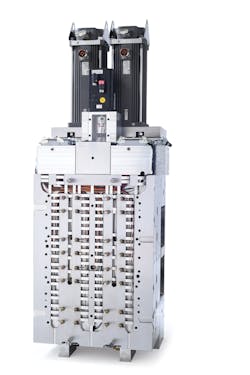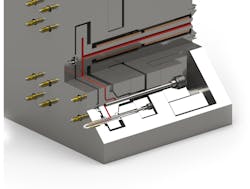Husky UltraShot combines hot-runner, injection functions
A new technology from Husky that combines injection and hot-runner functions can make possible parts once considered beyond the reach of traditional injection molding, a company official said.
Sheldon Alexander, a business manager for Husky’s new UltraShot melt-delivery technology, described it as a “new category of system.” It gives more freedom to part designers and promises more precision for molders hampered by high scrap rates while using traditional hot runners. Available in varying sizes to accommodate a range of needs, the UltraShot also offers scalability.
The system feeds and holds resin at relatively low pressures and temperatures, then injects it at the needed pressure, “and that injection point is as close to the cavity as possible, versus all the way back into the machine,” Alexander said. It is compatible with any manufacturer’s press and any mold, but uses Husky’s Altanium mold controller to take control of the injection molding machine on which it is installed.
Developed over the past decade, the UltraShot already has opened up possibilities for some of Husky’s molding partners that adopted the technology while it was in testing and in the months since it’s been released.
Medical molders are most likely to benefit, said Alexander, who acknowledged that the UltraShot is not for everyone. For most applications, single-stage molding is adequate. Two-stage molding addresses most other challenges, but for about 5 percent of molders working on particularly complex applications — involving small, precise parts weighing less than 10 grams, or engineering resins such as polyetherimide or PEEK — the UltraShot just might be the only solution, he said.
“Systems that we sold, or applications that we sold the system into, many of them are parts that the customer developed,” he said. “And they said, ‘OK, this is the part that I wanted to mold.’ They tried molding it on a one- or four-As an example, he cited the experiences of an UltraShot user that makes catheters. The medical devices feature two materials — one for a long tube that’s typically extruded and a second for a rubberized tip, which is typically injection molded, then ultrasonically welded to the tube. But, using the UltraShot, Husky’s customer can injection mold the tube, then overmold the tip onto it. The new process eliminates the need for three other work cells.
“I would say anybody in the industry would look at this part and say, ‘Yeah, it is impossible to injection mold, it’s just not possible.’ But we were able to do it; we were able to do the soft tip in the same mold. And that gave the customer better adhesion between the two parts, and significantly reduced costs,” he said.
In another example, Alexander described a manufacturer that scrapped between 2 percent and 8 percent of the medical diagnostic parts it made from a very corrosive resin. With UltraShot, the scrap rate plummeted to less than 1 percent.
With its high level of precision and control, the system delivers the same performance whether in operation for short runs or huge volumes, Alexander said. Not only did it allow the diagnostic parts maker to reduce scrap, it also provided a way for the molder to scale up — from a four-cavity tool to an eight-cavity tool, with four cavities devoted to one part and two cavities each devoted to two other parts.
The new tooling has proved more efficient, and reduced automation complexity; with it, the manufacturer is making 80 million parts a year.
Cost per part fell by 60 percent, according to Husky.
“What we do on our four-cavity prototype tool is that we have essentially an injection unit specific to those four cavities within the UltraShot system. And if the customer wants to scale up, they can scale up in any multiple of four. … We’re essentially duplicating that four-cavity mini work cell, mini-injection unit, UltraShot system, in any multiple of four,” Alexander said. “So, they can go from a four-[cavity tool] to a 48- or 96-cavity, and Husky is confident that they will see the same performance they saw on the four-cavity.”
Parts that might not have been molded before, or might have been molded only with function-compromising modifications, now have a chance to see market, thanks to the UltraShot’s ultra-close injection point, Alexander said.
“Being able to do that gives us better control due to the fact that plastic is compressible and shear-sensitive over that injection point all the way from the screw through as close as possible to the gate, to mitigate some of the negative effects that plastics have when it comes to resin compression, when it comes to shear,” he said. “That gives us better control over fill in the cavity because your injection point is so close to the cavity. It gives us higher pressure. It gives us a better melt quality. It gives us better balance. It gives us better cavities and cavity consistency and better shot-to-shot consistency.”
Karen Hanna, associate editor
Contact:
Husky Injection Molding Systems Ltd., Bolton, Ontario, 905-951-5000 , https://www.husky.co/
About the Author
Karen Hanna
Senior Staff Reporter
Senior Staff Reporter Karen Hanna covers injection molding, molds and tooling, processors, workforce and other topics, and writes features including In Other Words and Problem Solved for Plastics Machinery & Manufacturing, Plastics Recycling and The Journal of Blow Molding. She has more than 15 years of experience in daily and magazine journalism.


